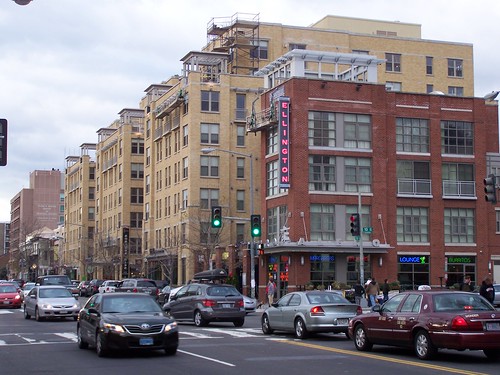Shaw (and Mid City East) as a one-over neighborhood: revitalization, displacement, gentrification as a function of critical mass and timing
I still haven't written about Live Baltimore, the national best practice example of an urban resident attraction program, and their new website, as an excuse to write about their approach.
One of the terms they've coined, which describes very well the phenomenon I've participated in myself as it relates to neighborhood choice is what they call "one-over neighborhoods," or neighborhoods next to the already successful neighborhood which already share the same characteristics or proximity.
In Baltimore, what it means is that if you can't afford to live in Charles Village, why not consider Waverly?, or Reservoir Hill when you can't afford Bolton Hill, Highlandtown when you can't find what you want in Canton or Patterson Park, etc.
In DC, ten years ago it meant, if you can't afford Capitol Hill, why not consider H Street? Now that H Street is rising, it means what about Trinidad. For me, instead of Takoma DC/Takoma Park, it means Manor Park, etc.
A couple years ago I wrote a piece that discussed the Shaw neighborhood in passing. I was in an intellectual argument with a then PhD student, Katie Wells, about revitalization (now she has finished but I haven't read her dissertation yet, A Decent Place to Stay: Housing Crises, Radical Laws, and a Historical Geography of Property in Washington, D.C., but I will).
 She made the point that Virginia Tech professor Derek Hyra argues that DC's Shaw neighborhood had been successful at warding off "gentrification."
She made the point that Virginia Tech professor Derek Hyra argues that DC's Shaw neighborhood had been successful at warding off "gentrification."My counter-argument was that this seeming case is more the result of a different timeframe for change, a function of the green line Metro opening there later than the other Metro lines, as well as an earlier focus on other areas close by such as Dupont East and Logan Circle, and with the influx of new housing on U Street, Shaw was entering a period of significant change. Just later, compared to places like Capitol Hill.
See "Revitalization in stages" but also "Low income, high income, [the housing] market, and the right to the city."
Judging by today's cover story on the Shaw neighborhood, "The Shaw Guide," in the Weekend section of the Washington Post, I would aver that I am correct. (Plus this article from August, "This is what Shaw's restaurant boom could look like.") From the article:
So what makes the rebirth of Shaw different? ... Start with the buildings. Many of the new projects — Shaw Main Streets counts more than 20 projects currently in the works — occupy existing real estate, some of which has been vacant or underutilized since the 1960s. Contrast this with the condo booms along 14th Street NW or in Columbia Heights; Shaw has a much more small-town feel.Logan Circle was the one-over neighborhood to Dupont Circle. Both U Street and Shaw are the one-over neighborhoods from Logan Circle.
I can't see any neighborhood in the central core of DC being able to be resistant from market forces in terms of maintaining the ability of the less well off to remain in place, barring other policy decisions in particular portfolio investment in maintaining permanently affordable housing, either as rental apartments or cooperatives.

This comes up too with the joint planning initiative by the DC Office of Planning and the Department of Transportation for the area they call Mid City East (pictured above), to create an anti-displacement plan and program (Mid City East Small Area Plan and Livability Study). It's been written up in GGW, "Plans seek to keep Mid City East affordable." From the GGW piece:
As U Street to the west and NoMa to the east have boomed, the Mid City East neighborhoods of LeDroit Park, Bloomingdale, Truxton Circle, Sursum Corda, and Eckington remain a relatively affordable option. However, as million-dollar houses pop up, neighbors want to secure the diversity and affordability that lend the neighborhoods their character.I didn't know about the planning initiative beforehand, but were such a plan to have any substantive impact, it needed to occur 10 years ago, at the time when it was clear that the velocity and trajectory of urban revitalization in the city was beginning to change significantly.
Since January, the DC Office of Planning (OP) and District Department of Transportation (DDOT) have been studying these neighborhoods and have released their draft recommendations for comment. The results here may provide lessons for what happens in similarly transitioning DC neighborhoods like Hill East or Anacostia, or Columbia Pike in Arlington.
Today, such a plan has infinitesimal chance to have impact because property values of the typical house in the Mid City area have long since climbed. Try finding a house there under $500,000.
And the new little cluster of restaurants at Rhode Island Avenue and 1st Street NW now boasts one of the city's leading restaurants, Red Hen--an Italian influenced restaurant no less--as an anchor.
cf. the controversial Natalie Hopkinson op-ed in the Washington Post from 2001, "I won't let DC lose its flavor," where she advocated a program of what we might call resistance or not selling properties to newcomers. That didn't work out.
Labels: gentrification, invasion-succession theory, neighborhood change, neighborhood planning, urban revitalization, urban sociology




0 Comments:
Post a Comment
<< Home